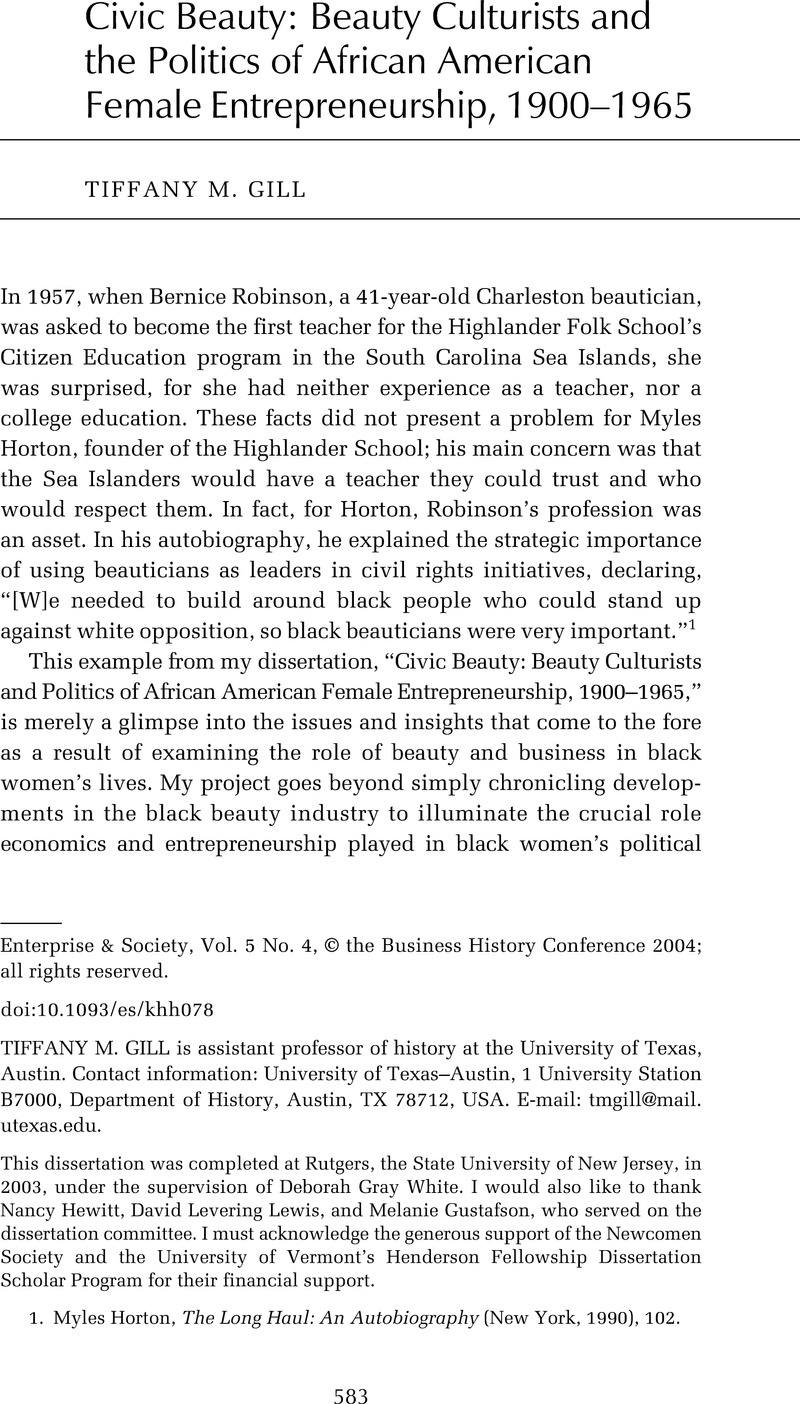Published online by Cambridge University Press: 18 February 2015

1. Horton, Myles, The Long Haul: An Autobiography (New York, 1990), 102.Google Scholar
2. Information on Martin Luther King, Jr.’s, 1957 speech to the National Beauty Culturists’ League is chronicled in Mark, Vernice, The National Beauty Culturists’ League History, 1919-1994 (Detroit, Mich., 1994), 36.Google Scholar For information on Ella Baker’s relationship with black beauticians, see Baker quoted in Robnett, Belinda, How Long, How Long: African American Women in the Struggle for Civil Rights (New York, 1997), 93.Google Scholar
3. Kelley, Robin D. G., “‘We Are Not What We Seem’: The Politics and Pleasures of Community,” in Kelley, Race Rebels: Culture, Politics, and the Black Working Class (New York, 1994), 35–53 Google Scholar, quotation at p. 44 (emphasis mine).
4. Evans, Sara M. and Boyte, Harry C., Free Spaces: The Sources of Democratic Change in America (New York, 1986), 17.Google Scholar I must acknowledge Rhonda Mawhood Lee for first interpreting the use of beauty parlors in the Jim Crow South as free spaces in her unpublished paper, “Tales to Curl Your Hair: African American Beauty Parlors in Jim Crow Durham,” seminar paper, Duke University, N.C., 1995.
5. Peiss, Kathy, Hope in a Jar: The Making of America’s Beauty Culture (New York, 1998), xx.Google Scholar
6. Gamber, Wendy, “A Gendered Enterprise: Placing Nineteenth Century Businesswomen in History,” Business History Review 72 (Summer 1998): 188–218 CrossRefGoogle Scholar; Walker, Juliet E.K., The History of Black Business in America (New York, 1998)Google Scholar; Kathy Peiss, Hope in a Jar; Weems, Robert, Black Business in the Black Metropolis: The Chicago Metropolitan Assurance Company, 1925-1985 (Bloomington, Ind., 1996)Google Scholar and Desegregating the Dollar: African American Consumerism in the Twentieth Century (New York, 1998); Kwoleck-Folland, Angel, Engendering Business: Men and Women and Business Office, 1870-1930 (Baltimore, Md., 1994)Google Scholar; Hammond, Theresa, A White Collar Profession: American Certified Public Accountants Since 1921 (Chapel Hill, N.C., 2002).CrossRefGoogle Scholar
7. Gamber, “A Gendered Enterprise,” 192.
8. Mark, , History of the National Beauty Culturists League, 19.Google Scholar
9. For a more detailed discussion of black women’s role in broker politics, see White, Deborah Gray, Too Heavy a Load: Black Women in Defense of Themselves (New York, 1999), 155.Google Scholar
10. National Beauty Culturists’ League, Daily Bulletin, 11 Aug. 1948, Series 18, Box 7 Folder 3, Records of the National Council of Negro Women, National Beauty Culturists League, Mary McLeod Bethune Council House, National Parks Service, Washington, D.C.
11. For a larger discussion of the afro, particularly the black beauty culture industry’s response, see Walker, Susannah, “Black is Profitable: The Commodifi-cation of the Afro, 1960-1975,” in Beauty and Business: Commerce, Gender and Culture in Modern America, ed. Scranton, Philip (New York, 2001), 254-77.Google Scholar On a discussion of the political and nonpolitical elements of “soul culture,” see Craig, Maxine Leeds, Ain’t IA Beauty Queen (New York, 2002)CrossRefGoogle Scholar; Davis, Angela, “Afro Images: Politics, Fashion, and Nostalgia,” in Soul: Black Power, Politics, and Pleasure, ed. Guillory, Monique and Green, Richard (New York, 1998)Google Scholar; DeBurg, William Van, New Day In Babylon: The Black Power Movement and American Culture (Chicago, 1992).CrossRefGoogle Scholar
12. Leak, Sylvester, “The Revolution in Hair Grooming—Is the Black Beautician Losing Fight for Life?” Muhammed Speaks, 26 Feb. 1965.Google Scholar
13. Davis, Elizabeth Lindsay, Lifting as They Climb (Washington, D.C., 1933), 262-63.Google Scholar